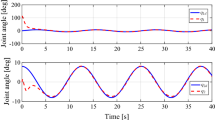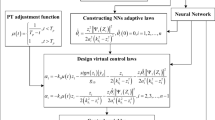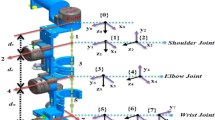Abstract
Accurate acceleration acquisition is a critical issue in the robotic exoskeleton system, but it is difficult to directly obtain the acceleration via the existing sensing systems. The existing algorithm-based acceleration acquisition methods put more attention on finite-time convergence and disturbance suppression but ignore the error constraint and initial state irrelevant techniques. To this end, a novel radical bias function neural network (RBFNN) based fixed-time reconstruction scheme with error constraints is designed to realize high-performance acceleration estimation. In this scheme, a novel exponential-type barrier Lyapunov function is proposed to handle the error constraints. It also provides a unified and concise Lyapunov stability-proof template for constrained and non-constrained systems. Moreover, a fractional power sliding mode control law is designed to realize fixed-time convergence, where the convergence time is irrelevant to initial states or external disturbance, and depends only on the chosen parameters. To further enhance observer robustness, an RBFNN with the adaptive weight matrix is proposed to approximate and attenuate the completely unknown disturbances. Numerical simulation and human subject experimental results validate the unique properties and practical robustness.
Similar content being viewed by others
References
Abooee A, Moravej Khorasani M, Haeri M, 2017. Finite time control of robotic manipulators with position output feedback. Int J Robust Nonl Contr, 27(16):2982–2999. https://doi.org/10.1002/rnc.3721
Aguirre-Ollinger G, Colgate JE, Peshkin MA, et al., 2007. Active-impedance control of a lower-limb assistive exoskeleton. 10th Int Conf on Rehabilitation Robotics, p.188-195. https://doi.org/10.1109/icorr.2007.4428426
Chen Q, Cheng H, Yue C, et al., 2018. Dynamic balance gait for walking assistance exoskeleton. Appl Bion Biomech, 2018:7847014. https://doi.org/10.1155/2018/7847014
Chen S, Chen Z, Yao B, et al., 2017. Adaptive robust cascade force control of 1-DOF hydraulic exoskeleton for human performance augmentation. IEEE/ASME Trans Mech, 22(2):589–600. https://doi.org/10.1109/TMECH.2016.2614987
Dong TY, Zhang XL, Liu T, 2018. Artificial muscles for wearable assistance and rehabilitation. Front Inform Technol Electron Eng, 19(11):1303–1315. https://doi.org/10.1631/FITEE.1800618
Fei J, Ding H, 2012. Adaptive sliding mode control of dynamic system using RBF neural network. Nonl Dynam, 70(2):1563–1573. https://doi.org/10.1007/s11071-012-0556-2
He S, Lin D, 2018. Reliable spacecraft rendezvous without velocity measurement. Acta Astron, 144:52–60. https://doi.org/10.1016/j.actaastro.2017.12.016
He Y, Li N, Wang C, et al., 2019. Development of a novel autonomous lower extremity exoskeleton robot for walking assistance. Front Inform Technol Electron Eng, 20(3):318–329. https://doi.org/10.1631/FITEE.1800561
Hua CC, Yang Y, Guan X, 2013. Neural network-based adaptive position tracking control for bilateral teleoperation under constant time delay. Neurocomputing, 113:204–212. https://doi.org/10.1016/j.neucom.2013.01.016
Huo WG, Mohammed S, Amirat Y, et al., 2016. Active impedance control of a lower limb exoskeleton to assist sit-to-stand movement. Proc IEEE Int Conf on Robotics and Automation, p.3530-3536. https://doi.org/10.1109/ICRA.2016.7487534
Kang I, Hsu H, Young A, 2019. The effect of hip assistance levels on human energetic cost using robotic hip exoskeletons. IEEE Robot Autom Lett, 4(2):430–437. https://doi.org/10.1109/LRA.2019.2890896
Kazerooni H, Racine J, Huang LH, et al., 2005. On the control of the Berkeley lower extremity exoskeleton (BLEEX). Proc IEEE Int Conf on Robotics and Automation, p.4353-4360. https://doi.org/10.1109/ROBOT.2005.1570790
Kim H, Shin YJ, Kim J, 2017. Design and locomotion control of a hydraulic lower extremity exoskeleton for mobility augmentation. Mechatronics, 46:32–45. https://doi.org/10.1016/j.mechatronics.2017.06.009
Kim J, Heimgartner R, Lee G, et al., 2018. Autonomous and portable soft exosuit for hip extension assistance with online walking and running detection algorithm. Proc IEEE Int Con on Robotics and Automation, p.5473-5480. https://doi.org/10.1109/ICRA.2018.8460474
Kim J, Lee G, Heimgartner R, et al., 2019. Reducing the metabolic rate of walking and running with a versatile, portable exosuit. Science, 365(6454):668–672. https://doi.org/10.1126/science.aav7536
Kuo CH, Yudha AP, Mohapatra SK, 2018. Force sensorless compliance control of a lower-limb exoskeleton robot. Int J Autom Smart Technol, 8(1):51–60. https://doi.org/10.5875/ausmt.v8i1.1565
Li S, Yang J, Chen WH, et al., 2011. Generalized extended state observer based control for systems with mismatched uncertainties. IEEE Trans Ind Electron, 59(12):4792–4802. https://doi.org/10.1109/TIE.2011.2182011
Long Y, Du ZJ, Wang WD, et al., 2018. Physical humanrobot interaction estimation based control scheme for a hydraulically actuated exoskeleton designed for power amplification. Front Inform Technol Electron Eng, 19(9):1076–1085. https://doi.org/10.1631/FITEE.1601667
Luenberger D, 1966. Observers for multivariable systems. IEEE Trans Autom Contr, 11(2):190–197. https://doi.org/10.1109/TAC.1966.1098323
Nagarajan U, Aguirre-Ollinger G, Goswami A, 2016. Integral admittance shaping: a unified framework for active exoskeleton control. Robot Auton Syst, 75:310–324. https://doi.org/10.1016/j.robot.2015.09.015
Polyakov A, 2011. Nonlinear feedback design for fixed-time stabilization of linear control systems. IEEE Trans Autom Contr, 57(8):2106–2110. https://doi.org/10.1109/TAC.2011.2179869
Seo K, Kim K, Park YJ, et al., 2018. Adaptive oscillator-based control for active lower-limb exoskeleton and its metabolic impact. Proc IEEE Int Conf on Robotics and Automation, p.6752-6758. https://doi.org/10.1109/ICRA.2018.8460841
Shtessel Y, Edwards C, Fridman L, et al., 2014. Sliding Mode Control and Observation. Springer, Berlin, Germany. https://doi.org/10.1007/978-0-8176-4893-0
Tan CP, Yu X, Man Z, 2010. Terminal sliding mode observers for a class of nonlinear systems. Automatica, 46(8):1401–1404. https://doi.org/10.1016/j.automatica.2010.05.010
Tanghe K, Aertbeliën E, Vantilt J, et al., 2018. Realtime delayless estimation of derivatives of noisy sensor signals for quasi-cyclic motions with application to joint acceleration estimation on an exoskeleton. IEEE Robot Autom Lett, 3(3):1647–1654. https://doi.org/10.1109/LRA.2018.2801473
Wang ZW, Liang B, Wang XQ, 2018. Chattering-free fixed-time control for bilateral teleoperation system with jittering time delays and state constraints. IFAC, 51(32):588–593. https://doi.org/10.1016/j.ifacol.2018.11.487
Wang ZW, Chen Z, Zhang YM, et al., 2019a. Adaptive finite-time control for bilateral teleoperation systems with jittering time delays. Int J Robust Nonl Contr, 29(4):1007–1030. https://doi.org/10.1002/rnc.4423
Wang ZW, Chen Z, Liang B, 2019b. Fixed-time velocity reconstruction scheme for space teleoperation systems: exp barrier Lyapunov function approach. Acta Astron, 157:92–101. https://doi.org/10.1016/j.actaastro.2018.12.018
Xiao B, Yin S, 2016. Velocity-free fault-tolerant and uncertainty attenuation control for a class of nonlinear systems. IEEE Trans Ind Electr, 63(7):4400–4411. https://doi.org/10.1109/TIE.2016.2532284
Xue T, Wang Z, Zhang T, et al., 2018. The control system for flexible hip assistive exoskeleton. Proc IEEE Int Conf on Robotics and Biomimetics, p.697-702. https://doi.org/10.1109/ROBIO.2018.8665203
Xue T, Wang Z, Zhang T, et al., 2019. Adaptive oscillator-based robust control for flexible hip assistive exoskeleton. IEEE Robot Autom Lett, 4(4):3318–3323. https://doi.org/10.1109/LRA.2019.2926678
Yang Y, Hua CC, Li JP, et al., 2017. Finite-time outputfeedback synchronization control for bilateral teleoperation system via neural networks. Inform Sci, 406:216–233. https://doi.org/10.1016/j.ins.2017.04.034
Yang ZY, Gu WJ, Zhang J, et al., 2017. Force Control Theory and Method of Human Load Carrying Exoskeleton Suit. Springer, Berlin, Germany. https://doi.org/10.1007/978-3-662-54144-9
Zhang T, Tran M, Huang H, 2019. Admittance shaping-based assistive control of SEA-driven robotic hip exoskeleton. IEEE/ASME Trans Mech, 24(4):1508–1519. https://doi.org/10.1109/TMECH.2019.2916546
Zhu Z, Xia Y, Fu M, 2011. Attitude stabilization of rigid spacecraft with finite-time convergence. Int J Robust Nonl Contr, 21(6):686–702. https://doi.org/10.1002/rnc.1624
Zoss AB, Kazerooni H, Chu A, 2006. Biomechanical design of the Berkeley lower extremity exoskeleton (BLEEX). IEEE/ASME Trans Mech, 11(2):128–138. https://doi.org/10.1109/TMECH.2006.871087
Author information
Authors and Affiliations
Contributions
Tao XUE and Zi-wei WANG designed the research. Meng ZHANG processed the data. Ou BAI drafted the manuscript. Bin HAN helped organize the manuscript. Tao ZHANG revised and edited the final version.
Corresponding author
Ethics declarations
Tao XUE, Zi-wei WANG, Tao ZHANG, Ou BAI, Meng ZHANG, and Bin HAN declare that they have no conflict of interest.
The Ethics Committee of Tsinghua University had reviewed the experimental procedure and method, and approved this experiment (No. 20200014). Before the experiment, all subjects signed the informed written consent and agreed to participate in this experiment.
Additional information
Project supported by the Move Robotics Technology Co., Ltd. and the National Natural Science Foundation of China (No. 51705163)
Rights and permissions
About this article
Cite this article
Xue, T., Wang, Zw., Zhang, T. et al. Fixed-time constrained acceleration reconstruction scheme for robotic exoskeleton via neural networks. Front Inform Technol Electron Eng 21, 705–722 (2020). https://doi.org/10.1631/FITEE.1900418
Received:
Accepted:
Published:
Issue Date:
DOI: https://doi.org/10.1631/FITEE.1900418
Key words
- Acceleration reconstruction
- Fixed-time convergence
- Constrained control
- Barrier Lyapunov function
- Initial state irrelevant technique
- Robotic exoskeleton




